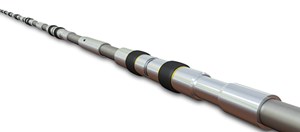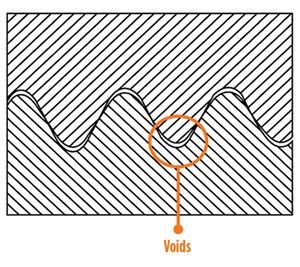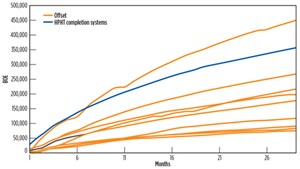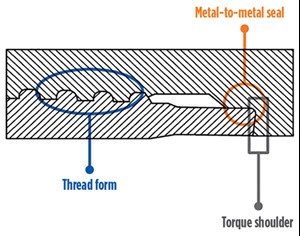HPHT environment requires reliable, high-strength completion systems
In 2010, the Duvernay formation in Western Canada was unchartered territory. With an estimated 73 Bbbl of oil and natural gas liquids, and 443 Tcf of natural gas in this unconventional shale play, the return on investment could be substantial1; but at depths ranging from 2,000–4,000 m, the challenge of extraction is nearly as daunting. Early in the play’s development, wells were completed using standard equipment rated to 10,000 psi. However, high formation breakdown pressures forced an operator to push a fracture treatment to 12,000 psi, well over the tool’s 10,000-psi maximum rating. After encountering problems in subsequent stages, the operation was shut down, due to downhole tool failure. It was obvious that tools with higher pressure ratings would be required to stimulate wells in the area.
HPHT CHALLENGES/KEY PLAYS
The Duvernay is just one of many formations around the world that has been categorized as high-pressure/high-temperature (HPHT), which is generally defined as pressure in excess of 10,000 psi and/or temperature greater than 300°F. As deeper formations in under-explored unconventional plays are being developed, operators are encountering wells with high formation pressures and/or temperatures. These new plays require completion tools capable of overcoming higher reservoir breakdown pressures to effectively stimulate the producing horizon and lower the risk of casing failure or other mechanical difficulties. Downhole tool failure or ineffective stimulation can negatively impact the economic viability of a well or field development. Typically, HPHT formations require a greater investment, so the risk of failure is significantly higher.
Continual improvements in completion technology have recently spurred greater access and development in HPHT areas. Well-known HPHT plays include northeastern British Columbia in Canada, on- and offshore wells near the Gulf of Mexico and Southeast Asia, and offshore wells in the North Sea and the Norwegian Sea, Fig 1. HPHT fields also are being developed in Australia and Argentina. A large offshore formation in the Persian Gulf will soon be exploited by neighboring stakeholders, including Saudi Arabia, Bahrain and Oman.

A primary challenge in designing HPHT completion tools is the integrity of metals and elastomers. These components must be able to withstand, and efficiently function in, extreme downhole conditions for up to days or months. Tools encounter higher mechanical loads and fluid friction in deeper wells, and mechanical integrity for casing and other metallic equipment generally loses significant strength, which leads to material failure at temperatures in excess of 400˚F. Furthermore, high bottomhole temperature results in significant temperature variations during stimulation, which may lead to additional mechanical stress on the tool string.
Elastomer degradation and failure are also a concern in HPHT environments. During stimulation, packers must seal effectively against the wellbore, overcoming potential damage from pipe movement, high compression loads, and thermal cycling.2
HPHT TOOL SOLUTIONS
To meet the needs of operators working in HPHT formations, a new suite of tools was required that have:
- A burst and collapse rating up to 15,000 psi for all components.
- An ability to maintain a pressure rating of 15,000 psi for actuation balls and the sealing mechanism in the fracture port.
- A capability of maintaining thermal stability despite extreme temperature fluctuations during stimulation, using industry-standard fluids.
Tool development/function. After an in-depth analysis and R&D program, the Titanium XV (TXV) line of tools for HPHT applications was introduced, Fig. 2. To increase the system’s structural integrity to withstand the harsh downhole environment, TXV is manufactured with high-strength steel that is considerably stronger than the standard 110 ksi steel used in conventional tools. The system incorporates metal-to-metal (MtM) seals designed to contain and focus elastomer extrusion.

Innovative thread design. Standard API long-thread casing (LTC) is equipped with eight-round threads. The conventional couplings have been used widely in the oilfield as casing and tool connectors. However, LTC was developed before the advent of horizontal wells. It is not designed to withstand the mechanical stresses associated with installing and pressuring tools through bends and curves, Fig. 3. Furthermore, since the threads are not gas-tight, they are the weak link in the tool string, especially at higher pressures and in the bend sections. Finally, thread jumping failures are common with LTC, when the casing is stressed with high pressure/high tensile and/or compressive loads.
To solve these issues, TXV tools have a proprietary thread design that incorporates high-torque shouldered connections with a small back angle on the face, creating a larger surface area for efficient torque make-up, Fig. 4. The thread is designed with premium MtM seals for containment of fluid/gases and improved structural integrity. The thread system can match, or exceed, the pressure rating of the tool body and the casing string.
The system, which has the same function as StackFRAC, uses a continuous pumping operation to effectively stimulate isolated zones along the entire length of the wellbore. This enables operators to greatly simplify multi-stage fracturing operations, reducing completion time and cost. After stimulation, the well can be flowed back immediately and put on production. The TXV system is modular and can be combined with other tools to customize the delivery of a specific stimulation program.
CASE STUDIES
The Cooper basin is one of the most significant onshore petroleum and natural gas deposits in South Australia. However, downhole tools in these wells are exposed to temperatures up to 400˚F, fracture gradients as high as 1.4 psi/ft, and fracture closure stresses up to 0.9 psi/ft. In one well, an operator planned to stimulate six cemented and pre-perforated zones over 656 ft and required tools that could withstand 350˚F and 15,000 psi. The service-provider designed a 3½-in., 6-stage TXV system, for a 7-in. cased hole vertical well, with five drillable closeable sleeves and one hydraulic sleeve at the toe of the well. The first stage was opened hydraulically to establish a flowpath and communication with the reservoir, and the remaining five stages were ball-triggered and hydraulically activated to isolate and fracture the pre-perforated zones of the cased-hole wellbore. Annular stage isolation was achieved using TXV cased hole packers.
Following the successful operation, production from the well stabilized at 2.2 MMscfgd. This cased, vertical well led to the discovery of a new gas field in the Cooper basin, and reflects the expanded capabilities of HPHT completion technologies to be applied in challenging shale play operations.
Case study 2: Deep Duvernay wells (Canada). In British Columbia, operators developing the Duvernay shale, which lies beneath the well-developed Montney formation, are faced with depth challenges between 2,000–4,000 m. To solve these issues, an openhole TXV ball-drop system was developed, which combined a single-point entry frac tool, with limited-entry frac technology, to complete a 31-stage well. The toe stage was opened, using a hydraulically activated port sleeve, followed by multiple limited-entry sleeves for stimulation treatment in the next 24 stages. The final six stages were completed, using a single TXV port sleeve for each stage.
The fracture treatment operation was challenging. During stimulation, pressure reached 11,200 psi, and 200 metric tons of proppant were placed per stage. After 16 months, cumulative gas production from the well reached 995 MMcf, with accompanying condensate production of 66,000 bbl. At the time, this was the second-highest cumulative production of all wells completed in the Duvernay, Fig. 5.
After completing several cased hole wells in the Duvernay, another operator reduced its completion costs by running the service provider’s openhole completion system with a monobore well design.
The 20-stage completion included a TXV cementor stage collar to cement the vertical and build sections from the heel of the well. The operation was completed in less than 60 hr of pumping time, and used approximately 169,200 bbl of fluid.

The company’s CEO stated in quarterly financial results that costs for a second completion using the same system had been reduced by approximately 30%. Since then, the operator has expanded its use of the technology to other operations in the Duvernay.
Case study 3: HP application in Oman. Wells in Oman’s Khazzan field typically have been completed using cemented plug-and-perf operations. An operator discovered that the formations in the field were difficult to break down, despite using 10,000-psi-rated equipment. Production from a number of other plug-and-perf wells did not meet the operator’s expectations.
To effectively stimulate the productive interval, the operator required a system with a higher pressure rating, and one robust enough to function through temperature fluctuations of more than 100˚F.
In switching to an openhole completion system, the operator required tools with a working pressure of 15,000 psi, and an even higher maximum pressure rating. Several upgrades were made to the TXV system specifically for this operator, and testing to meet the unique standards began just five weeks after the start of the design process. The final system achieved a working pressure of 15,000 psi, with a maximum pressure rating of 18,300 psi.
Using these tools, the operator executed a hybrid completion, using the new system for the lower stages and plug-and-perf for the upper stages. The stimulation was completed without issue, and initial production results have been extremely encouraging.
Case study 4: Offshore UAE. The carbonate Shilaif reservoir in the United Arab Emirates is typically stimulated with acid. However, one operator observed that production from their acid-treated wells was poor, and sought an alternative solution. A TXV completion system was selected as a multi-stage HPHT technology to deliver a proppant-based completion, instead of the acid stimulation that was standard practice in the region.
A 4½-in. liner and multi-stage ball-drop system were installed in the offshore well. All eight stages were completed in 48 hr, in a single, continuous pumping operation. Indications of proper isolation were observed throughout the completion. The delivery and execution of the operation were accomplished with zero recordable injuries or environmental incidents. This completion is believed to be the first offshore proppant-based, multi-stage completion in this reservoir.
IMPROVING HPHT ECONOMICS
Advancements in HPHT completion technologies have enabled operators to efficiently develop more challenging formations. Since its early development in the Duvernay formation, the TXV completion system has been used in more openhole wells than any other HPHT system provided.
The new suite of HPHT technology is helping to open new opportunities in a variety of worldwide applications while mitigating risks, including burst and collapse, due to high pressure and seal integrity in high-temperature applications. The capability to avoid these issues provides operators with the ability to conduct an effective stimulation for every stage of the wellbore, significantly improving the chances of an economic well. ![]()
REFERENCES
- Alberta Geological Survey.
- HPHT 101-What Petroleum Engineers and Geoscientists Should Know About High Pressure High Temperature Wells Environment, Canadian Research & Development Center of Sciences and Cultures.
- What's new in production (February 2024)
- Using data to create new completion efficiencies (February 2024)
- U.S. operators reduce activity as crude prices plunge (February 2024)
- U.S. producing gas wells increase despite low prices (February 2024)
- U.S. oil and natural gas production hits record highs (February 2024)
- Dallas Fed: E&P activity essentially unchanged; optimism wanes as uncertainty jumps (January 2024)
- Applying ultra-deep LWD resistivity technology successfully in a SAGD operation (May 2019)
- Adoption of wireless intelligent completions advances (May 2019)
- Majors double down as takeaway crunch eases (April 2019)
- What’s new in well logging and formation evaluation (April 2019)
- Qualification of a 20,000-psi subsea BOP: A collaborative approach (February 2019)
- ConocoPhillips’ Greg Leveille sees rapid trajectory of technical advancement continuing (February 2019)




